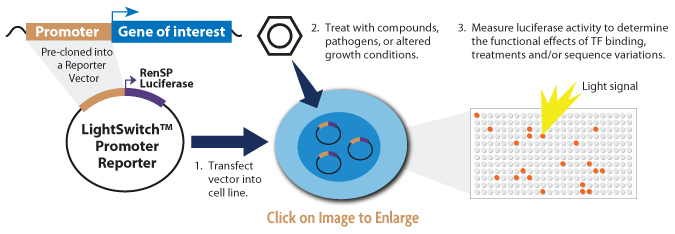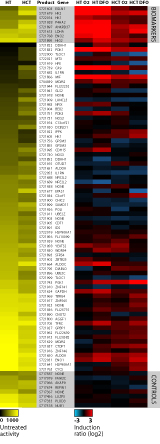HIF-1α-related Assays (Hypoxia)
HIF-1-related-Assays-Hypoxia-AM1109
Synonyms
| Name | Format | Cat No. | Price |
|---|
Overview
The LightSwitch™ Hypoxia (HIF-1α) Pathway Collection is a comprehensive set of sequence-verified, transfection-ready, promoter reporter constructs that can be used to accurately quantify transcriptional activation and repression in response to induction of the hypoxia pathway. These constructs are a subset of the 18,000-member LightSwitch Promoter Reporter GoClone® Collection that were selected based on sequence motif analysis, published information and in-house analysis of each promoter's activity* using our LightSwitch Luciferase Assay.
The Hypoxia (HIF-1α) Biomarker Set contains 8 of the highest responding promoters under our chosen test conditions, as well as the promoters of 2 housekeeping genes (Figure 1). The Hypoxia (HIF-1α) Profiling Plate contains 88 promoter reporter constructs that showed significant activation or repression in response to induction (See the Hypoxia (HIF-1α) Profiling Plate tab below for data and a list of constructs).
Figure 1: Induction ratios for each member of the Hypoxia (HIF-1α) Biomarker Set.HT1080 human fibrosarcoma cells were transfected with the promoter reporter constructs shown, then incubated at 1% O2 or grown normally. After 24 hours, each sample was assayed using the LightSwitch Luciferase Assay Kit. The graph shows the ratio of treated/untreated signal on a log scale; error bars represent one standard deviation. “NONE” = No gene annotation. Please see the heatmap under the Profiling Plate tab below for relative promoter activities under untreated conditions.
*Experimental results and the absolute values of luciferase units may vary depending on cell line, treatment and protocols. All data shown is solely for use as a guide for selecting candidate promoters and panels for your particular experimental design.
Overview
Hypoxia (HIF-1α) Pathway
Hypoxia, low oxygen concentration in cells, is a characteristic of various physiological processes such as the regulation of cell differentiation, blood vessel formation, and wound healing. Hypoxia is also widely associated with diseases such as anemia, diabetes, kidney disease, cardiovascular disease, hypertension, sickle cell disease, and many cancers. Cells under hypoxic stress activate a signaling cascade of hypoxia-responsive genes to aid the cell into either adapting to the low oxygen conditions or undergoing apoptosis. This response to restore cellular homeostasis is primarily initiated and regulated by the family of hypoxia inducible transcription factors (HIF-1α).
Applications
The collection of validated LightSwitch HIF-1α-related promoter reporters enables you to:
- Understand the mechanisms by which hypoxia regulated genes are induced or repressed
- Quantify the functional consequences of transcription factor binding – while many other technologies give a qualitative view of transcription factor level, our promoter reporter assays quantify the effects of transcription factor binding
- Confirm data from ChIP, ChIP-chip or ChIP-Seq experiments
- Measure the effect of sequence variants and mutagenesis on promoter function
- Screen for promoter activation or develop activity profiles across the hypoxia signaling pathway for many compounds or conditions in parallel
Hypoxia and cancer: Application highlight
Hypoxia is a common trait in tumors, attributable to insufficient vascularization. Cell response to hypoxic stress is primarily mediated through the transcription factor hypoxia inducible factor 1 (HIF-1). Low oxygen concentration induces HIF to regulate genes involved in restoring cellular homeostasis such as erythropoietin, glycolytic enzymes and vascular endothelial growth factor (VEGF). Understanding the regulation and mechanisms of hypoxia-induced gene expression can provide critical insights into cancer pathogenesis.
Hypoxic conditions in tumors also cause resistance to radiotherapy and chemotherapy, creating considerable interest in the development of anti-hypoxia drugs. Although HIF-1 inhibition in hypoxic tumor cells may confer therapeutic benefits, evaluating the full HIF-1 pathway is critical for efficient screening of small molecules and minimizing off-target effects.
LightSwitch Luciferase Assay System
The LightSwitch Luciferase Assay System is a complete solution for studying transcriptional & post-transcriptional gene regulation in living mammalian cells. It enables you to directly measure the functional activity of promoters and 3´UTRs through use of an engineered luciferase gene (RenSP) and optimized assay & transfection reagents that ensure superior, reproducible results. In addition to Validated Pathway Collections, the LightSwitch System includes collections of over 30,000 cloned human promoter reporter constructs and human 3´UTR reporter constructs, miRNA mimics and inhibitors, as well as collections of synthetic long-range response element constructs and synthetic 3´UTRs target validation constructs that can provide more sensitivity than endogenous sequences.
LightSwitch Promoter Reporter Assays.To study a promoter's regulation, it is cloned into a LightSwitch Reporter vector upstream of the RenSP luciferase gene and then transfected into mammalian cells. The cells are stimulated, if required, to induce transcription of RenSP luciferase from the cloned promoter. Promoter activity is then quantified using a LightSwitch Luciferase Assay Kit and a luminometer to measure the amount of luminescence produced.
Advantages of the LightSwitch Luciferase Assay System
- Quantitative – Novel RenSP luciferase technology allows you to measure promoter activity with industry-leading sensitivity and dynamic range.
- Simple, fast, complete solution – With pre-cloned LightSwitch Reporter vectors and optimized transfection & assay reagents, you can study regulation of your gene today. No cloning, DNA preparation or optimization is needed, and most studies do not require any internal transfection controls.
- Comprehensive and verified – The genome-wide LightSwitch Reporter Collections are sequence-verified, transfection-ready promoter and 3´UTR reporter vectors.
- Functionally insightful – Learn about the actual effects of transcription factor binding to verify computational predictions and supplement microarray or sequencing data.
- Cost-effective – Efficiently screen for activation and/or repression using a multitude of conditions.
Hypoxia (HIF-1α) Profiling Plate
LightSwitch™ Hypoxia (HIF-1α) Pathway Profiling Plate
The Hypoxia (HIF-1α) Profiling Plate is a subset of promoter reporter constructs chosen from the LightSwitch Promoter Reporter GoClone® Collection. Promoters that were expected to be up- or down-regulated in the hypoxia pathway were chosen based on motif analysis and published information. In-house luciferase testing was then performed to select those promoter reporter constructs that were activated or repressed in response to our induction methods, which were to incubate HT1080 and HCT116 cells at 1% O2, or to treat them with 100 µM DFO for 24 hours, following transfection.
Hypoxia (HIF-1α) Profiling Plate heatmap
The heatmap at right shows the untreated and induced activity for all constructs that are members of the pathway profiling plate. On the right side of the figure, the colors represent log2 transformed ratios of treated/untreated activity according to the color scale shown at the base of the heatmap. Black indicates no change; the intensity of red or blue color indicates levels of induction or repression, respectively. On the left side of the figure, the intensity of yellow color depicts the activity of each promoter in “HT” cells (HT1080 human fibrosarcoma cells) or “HCT” cells (HCT116 human colorectal cancer cells) in the unstimulated (untreated) condition. All untreated signals are relative to the highest and lowest values within the individual experiment. (“O2” = Cells incubated at 1% O2 for 24 hours; “DFO” = Cells treated with 100 µM DFO for 24 hours.)
Hypoxia (HIF-1α) Profiling Plate contents
The Hypoxia (HIF-1α) Profiling Plate includes 88 promoter reporter constructs (including the 8 top-responding constructs that comprise the Hypoxia (HIF-1α) Biomarker Set, as well as 8 housekeeping / random promoters that are unlikely to respond to conditions that induce hypoxia). The controls can be used to correct for non-specific changes in overall signal in response to the stimulus. For example, some compounds used for induction are very toxic and result in a significant decrease in overall luciferase signal across the entire panel of constructs in a non-promoter-specific manner. Also included in the plate are 8 transfection controls that are used to determine the conditions that yield maximum transfection efficiency and reproducibility.
Ordering
If you would like to order 5 or fewer members of the Hypoxia (HIF-1α) Profiling Plate, you can use the Product IDs found in the file for the plate map above to order directly on Active Motif's SwitchGear Genomics website. If you wish to order the entire plate (or a minimum of 5 or more members), click here to send us an e-mail detailing which constructs you would like, and what amount (5 µg, 10 µg, 1 mg, etc.). We will send you a quote based on your request.
Contents
The Hypoxia (HIF-1α) Biomarker Set contains 5 µg aliquots each of 8 promoter reporter constructs and 2 housekeeping promoter constructs (NO_ANNOTATION & NUB1) for use as controls. Click on the links below for clone information.
EGLN1 (S721603)
ENO2 (S721768)
HIG2 (S721895)
HK1 (S722014)
HK2 (S721679)
LDHA (S721613)
P4HA2 (S721928)
NO_ANNOTATION (S717587)
NUB1 (S717518)
The Hypoxia (HIF-1α) Profiling Plate includes 88 promoter reporter constructs and 8 transfection control constructs (4 constructs from housekeeping genes with promoter activities of varying strengths (P1-P4), and 4 constructs with random 1 kb fragments (R1-R4)). To download a plate map with links to clone information, please click here.


